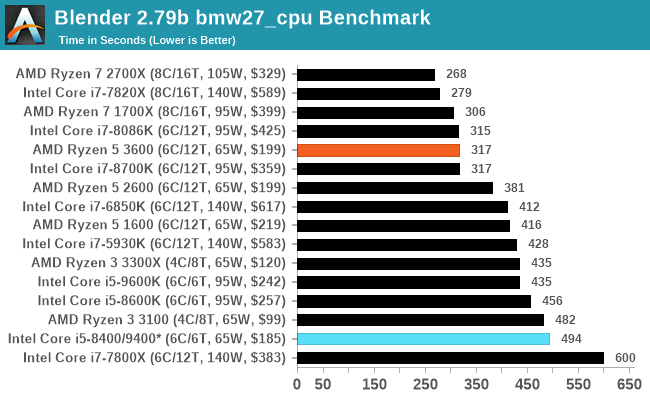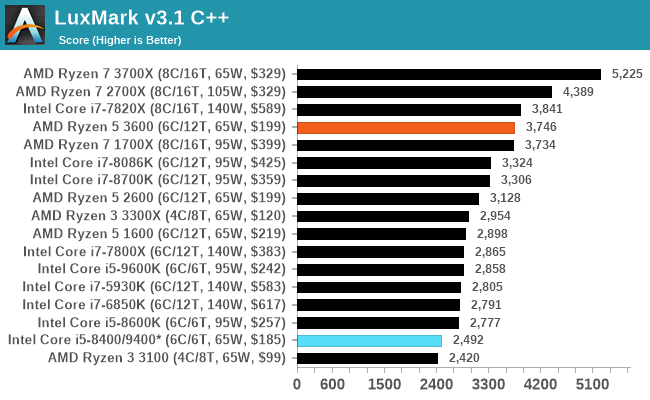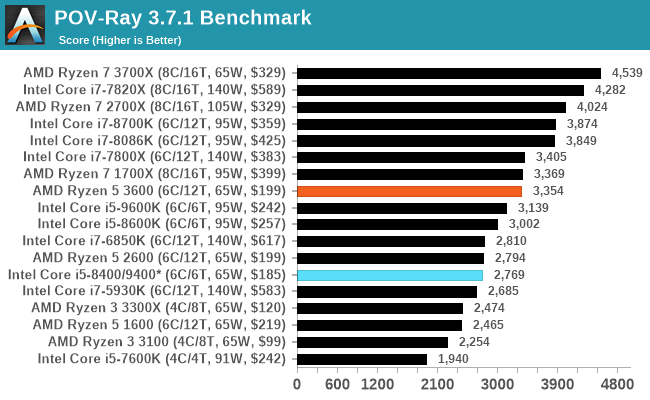AMD Ryzen 5 3600 Review: Why Is This Amazon's Best Selling CPU?
by Dr. Ian Cutress on May 18, 2020 9:00 AM ESTCPU Performance: Rendering Tests
Rendering is often a key target for processor workloads, lending itself to a professional environment. It comes in different formats as well, from 3D rendering through rasterization, such as games, or by ray tracing, and invokes the ability of the software to manage meshes, textures, collisions, aliasing, physics (in animations), and discarding unnecessary work. Most renderers offer CPU code paths, while a few use GPUs and select environments use FPGAs or dedicated ASICs. For big studios however, CPUs are still the hardware of choice.
All of our benchmark results can also be found in our benchmark engine, Bench.
Corona 1.3: Performance Render
An advanced performance based renderer for software such as 3ds Max and Cinema 4D, the Corona benchmark renders a generated scene as a standard under its 1.3 software version. Normally the GUI implementation of the benchmark shows the scene being built, and allows the user to upload the result as a ‘time to complete’.
We got in contact with the developer who gave us a command line version of the benchmark that does a direct output of results. Rather than reporting time, we report the average number of rays per second across six runs, as the performance scaling of a result per unit time is typically visually easier to understand.
The Corona benchmark website can be found at https://corona-renderer.com/benchmark

Blender 2.79b: 3D Creation Suite
A high profile rendering tool, Blender is open-source allowing for massive amounts of configurability, and is used by a number of high-profile animation studios worldwide. The organization recently released a Blender benchmark package, a couple of weeks after we had narrowed our Blender test for our new suite, however their test can take over an hour. For our results, we run one of the sub-tests in that suite through the command line - a standard ‘bmw27’ scene in CPU only mode, and measure the time to complete the render.
Blender can be downloaded at https://www.blender.org/download/

LuxMark v3.1: LuxRender via Different Code Paths
As stated at the top, there are many different ways to process rendering data: CPU, GPU, Accelerator, and others. On top of that, there are many frameworks and APIs in which to program, depending on how the software will be used. LuxMark, a benchmark developed using the LuxRender engine, offers several different scenes and APIs.
In our test, we run the simple ‘Ball’ scene on both the C++ and OpenCL code paths, but in CPU mode. This scene starts with a rough render and slowly improves the quality over two minutes, giving a final result in what is essentially an average ‘kilorays per second’.

POV-Ray 3.7.1: Ray Tracing
The Persistence of Vision ray tracing engine is another well-known benchmarking tool, which was in a state of relative hibernation until AMD released its Zen processors, to which suddenly both Intel and AMD were submitting code to the main branch of the open source project. For our test, we use the built-in benchmark for all-cores, called from the command line.
POV-Ray can be downloaded from http://www.povray.org/












114 Comments
View All Comments
flyingpants265 - Monday, May 18, 2020 - link
Haha, I knew somebody would would be slow enough to say that.Spunjji - Tuesday, May 19, 2020 - link
Why are so many people who make terrible points under the impression that it's their critics who are slow?dromoxen - Thursday, May 28, 2020 - link
perhaps the slow one is the Flying trousers .. You have already paid out 100 so to upgrade you would need to spend an extra 290 cadshabby - Monday, May 18, 2020 - link
I paid 10k for a used corvette, who in their right mind would pay 60k for a new one...flyingpants265 - Monday, May 18, 2020 - link
I guess nobody, if the only advantage is a 15% performance increase. Thanks for proving my point!Spunjji - Tuesday, May 19, 2020 - link
😴lmcd - Wednesday, May 27, 2020 - link
Someone had to buy the original for there to be a used oneIf no one buys the original, there will be no used ones for you to buy
dudedud - Monday, May 18, 2020 - link
Why does the ryzen 3 3300X scores so high in DigiCortex even with half the cores of the 3700X?Or is a typo?
GreenReaper - Monday, May 18, 2020 - link
Probably because the interaction between the cores matters, and the 3700X has cores on two separate complexes.silverblue - Monday, May 18, 2020 - link
I got a 3600 recently, and it works fine on my Gigabyte GA-AB350-Gaming 3, a B350 board from mid-2017. It does occasionally peak up to about 4.15GHz as far as I can tell from Ryzen Master, which is in no doubt helped by reusing my 1600's v1 Spire, along with MX-4 paste, in place of the packaged Stealth. Folding can still push temperatures up pretty high, especially if handling CPU and GPU work orders at the same time; partly thanks to having a Sapphire Nitro+ RX 590, CPU temperatures were spiking to the low 90s Celsius, but a combination of two new Corsair ML120 case fans (twice as effective as the Aerocool intake fan/ancient Akasa exhaust fan combo I had before) plus some slightly tweaked fan profiles knocked this down nearly ten degrees, along with boosting CPU folding speed a little. It's a great CPU, though I wish I had more than an RX 590 to go along with it.